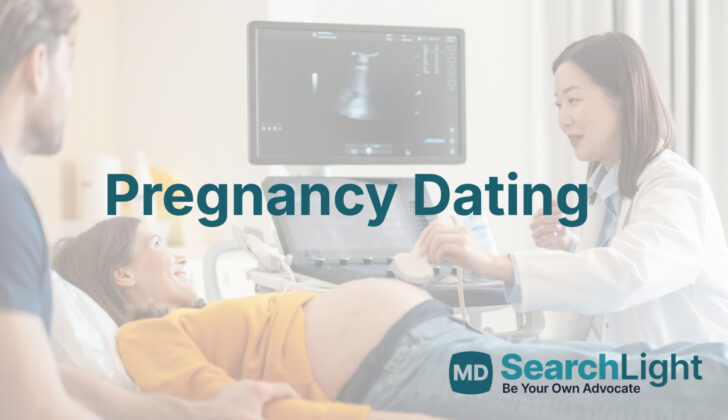Overview of Pregnancy Dating
The first and most essential step when meeting any expecting mother for the first time is figuring out her exact due date (check out the Pregnancy Timeline image). Getting the due date right is essential for many reasons. Knowing precisely how far along the pregnancy is determines the correct timing for check-up visits and certain treatments (have a look at the Birth Weight for Gestational Age Chart image).
For instance, certain prenatal tests – like the quadruple marker screen, a test checking for possibility of certain birth defects in babies – need a precise understanding of how far along the pregnancy is for the lab results to be interpreted correctly.
For mothers who have experienced preterm labor and delivery in the past, early tests and actions can be taken in the current pregnancy to prevent another premature birth. As the pregnancy develops, having the right pregnancy timeline is crucial to decide on the timing of both necessary medical and chosen deliveries.
Anatomy and Physiology of Pregnancy Dating
A pregnancy ultrasound is a test that uses sound waves to create images of the baby inside the womb. It also looks at the uterus and other structures nearby. In the very first ultrasound, the doctor will check where the baby is growing inside the uterus. They will also confirm that the baby is growing in the right place inside the uterus. The doctor will note down whether they can see the yolk sac, which is an early source of nutrients for the baby, and the fetal pole, the thick area at one end of the yolk sac that the baby will develop from. In addition, they will also record if there’s more than one baby. If the fetal pole is visible, the doctor will check for the baby’s heartbeat. If the ultrasound is done after 18 weeks of pregnancy, it can show the doctor more details about the baby’s body.
Why do People Need Pregnancy Dating
For the right care during pregnancy, it’s important to know how far along in the pregnancy you are; this is known as your ‘gestational age’. Every pregnant woman should have an ultrasound exam, either on the belly (abdominal) or inside the vagina (transvaginal), to confirm or find out the gestational age before the 22nd week of pregnancy. If this doesn’t happen, the dating of the pregnancy might not be as accurate as it could be.
When a Person Should Avoid Pregnancy Dating
Ultrasound, a type of imaging technique, has been employed for more than half a century in the field of pregnancy care, and it’s perfectly harmless when used correctly. However, the energy needed for ultrasound to create pictures can impact body tissues. Therefore, it’s advised to use ultrasound only when it’s absolutely necessary for medical reasons and for as brief a duration as possible.
Equipment used for Pregnancy Dating
When figuring out how far along a pregnancy is, some people use the date of the patient’s last menstrual period. This method, known as Naegele’s rule, involves keeping track of dates on a calendar. However, using ultrasound technology is generally the most reliable way to determine pregnancy stage. This is especially true when the ultrasound is done during the first three months of pregnancy.
An ultrasound takes pictures of the inside of the body using sound waves. In this context, it’s used to look at the baby growing in the womb. Transvaginal ultrasound is a specific type of ultrasound where a high-frequency (6-MHz to 10-MHz) probe, or scanner, is inserted into the vagina. This scanner can provide a picture of the baby and its surroundings a week earlier in the pregnancy than other types of scanners.
After the first 8 weeks of pregnancy, doctors usually use a different type of ultrasound called a transabdominal ultrasound. This scan is done by moving a curved scanner (with a frequency of 3 MHz to 6 MHz) along the surface of the abdomen. This method allows the doctor to take a good look inside the uterus. However, if the mother has a larger abdomen or if her uterus tilts backwards (a condition known as a retroverted uterus), it might be harder to get a clear image using this method.
Whether a transvaginal or transabdominal ultrasound is used, a special type of gel is needed to help the scanner slide easily and improve the quality of the images, this is known as an acoustic gel.
Who is needed to perform Pregnancy Dating?
A doctor usually figures out the expected due date for a woman who is pregnant. Sometimes, a person who is trained in doing ultrasounds (which are special pictures of the baby in the womb) is the first to check the pregnancy with this method. The due date given by the ultrasound, along with other ways of estimating it, should be looked at by the doctor. They will pick the most accurate estimate of how far along the pregnancy is, using certain guidelines.
Preparing for Pregnancy Dating
Preparation for an ultrasound scan can be different based on the type of method being used. If the ultrasound is happening on the area of your stomach (called a transabdominal ultrasound), having a full bladder can be helpful, but it’s not necessary.
On the other hand, if you’re having an ultrasound performed inside your vagina (transvaginal ultrasound), a full bladder can actually move the womb (uterus) towards the back, making it hard for the doctors to examine. Therefore, for this type of ultrasound, you are usually advised to make sure your bladder is empty.
The position in which you lie down during the ultrasound also depends on the method. If you’re having a stomach ultrasound, the doctors tend to perform this when you’re lying flat on your back (supine position). If it’s a transvaginal ultrasound, you’ll be in a position like you’re about to give birth (lithotomy position), i.e., your posterior is at the edge of the table. This allows the doctors to move the ultrasound probe in the necessary angles for a complete scan.
How is Pregnancy Dating performed
Doctors estimate a baby’s due date in a few different ways. One common method uses your last menstrual cycle. Seven days, plus nine months, or a total of 280 days added to the first day of your last menstrual cycle helps predict your due date. This method assumes a regular 28-day menstrual cycle, and that an egg is released on day 14 of the cycle.
Sometimes, doctors use a physical examination called a ‘fundal height measurement.’ This checks the distance from the top of your uterus to your pubic bone. This measure usually equals the number of weeks of your pregnancy, but can be less reliable if, for example, you’re dealing with uterine fibroids, or are overweight. However, this measurement can be helpful in places where it’s harder to access resources for more accurate dating of pregnancy.
The most accurate method to find out how far along your pregnancy is, is to have an ultrasound in the first trimester (or before 13 weeks and 6 days of pregnancy). This can be done either through the abdomen or through the vagina. The ultrasound measures the length from the top of baby’s head to its bottom, and averaging of this number from 3 separate measurements can improve its accuracy. If the mother knows the first day of her last menstrual period, that date should be the reference for deciding the baby’s age before the ultrasound. If the ultrasound measurement disagrees with the menstrual cycle date by 5 days or more when the ultrasound is done early (before 9 weeks), or by 7 days or more when done later (between 9 weeks and 13 weeks and 6 days), then the ultrasound measurement should be used to estimate the due date.
Unfortunately, it’s not always possible to get an ultrasound in the first 13 weeks of pregnancy. In places where resources for healthcare are scarce, women can get their first ultrasound between 18 to 20 weeks. This is not as precise for deciding due dates but will still give an estimate and also a thorough check of the baby’s anatomy. Second trimester ultrasound (between 14 weeks and 0 days and 27 weeks and 6 days) is not as precise as first trimester ultrasound, but it still gives a reasonable estimate of due date. However, if a woman had an ultrasound in the first trimester, the doctor should not change her due date based on a second trimester ultrasound.
When an ultrasound measures the baby’s age during the third trimester, it is the least accurate method, usually off by about three to four weeks. This is especially tricky when the baby is smaller than average for their age. Therefore, decisions on managing the pregnancy may be challenging when based solely on a third trimester ultrasound.
Possible Complications of Pregnancy Dating
After figuring out the expected date when a baby will be born using an ultrasound during the first or second three-month period of pregnancy, the date is marked in the patient’s medical records. This is done so that if other doctors or healthcare professionals need it, they can find it easily. It’s really important to note that if this date has to be changed, it can impact how the pregnancy is managed. So, before any changes are made to the estimated due date, the patient should be informed about what it could mean for them and their baby.
What Else Should I Know About Pregnancy Dating?
Understanding the precise stage of pregnancy and the estimated due date is crucial for managing any pregnancy. This information allows doctors to schedule lab tests and screenings at the right time during the pregnancy.
Knowing the stage of your pregnancy accurately before the 22nd week is particularly important as it helps doctors monitor the baby’s growth as pregnancy progresses. Pregnancies that aren’t accurately dated can be hard to manage due to uncertainties. For example, ultrasounds can sometimes make mistakes in late-stage pregnancies. Elective delivery, which is scheduling to give birth to the baby rather than waiting for labor, should not be done in these situations.
If there are clear medical reasons to deliver the baby (like pre-eclampsia, a condition causing high blood pressure, or gestational diabetes, a condition causing high sugar levels in the body), the delivery planning must be based on a good estimate of the pregnancy stage. One should not routinely use a procedure called amniocentesis, which tests the baby’s lung maturity, before planning for delivery in these instances. Even if the baby’s lungs are mature, babies born a little earlier than usual have a higher risk of issues related to breathing.
It is usually preferred to schedule an elective delivery at 41 completed weeks due to concerns that the baby could be further along than estimated by ultrasound in the third trimester. If there is uncertainty about the stage of the pregnancy, after the 39th week, tests can be done to monitor the fetus due to the risk of pregnancy going beyond the due date.
In cases where a pregnancy has not been accurately dated, if the expectant parent has previously had a cesarean birth and wants to have another one (this is known as a repeat low transverse cesarean delivery), it should be performed at 39 weeks, based on the best estimate of the pregnancy’s stage.












